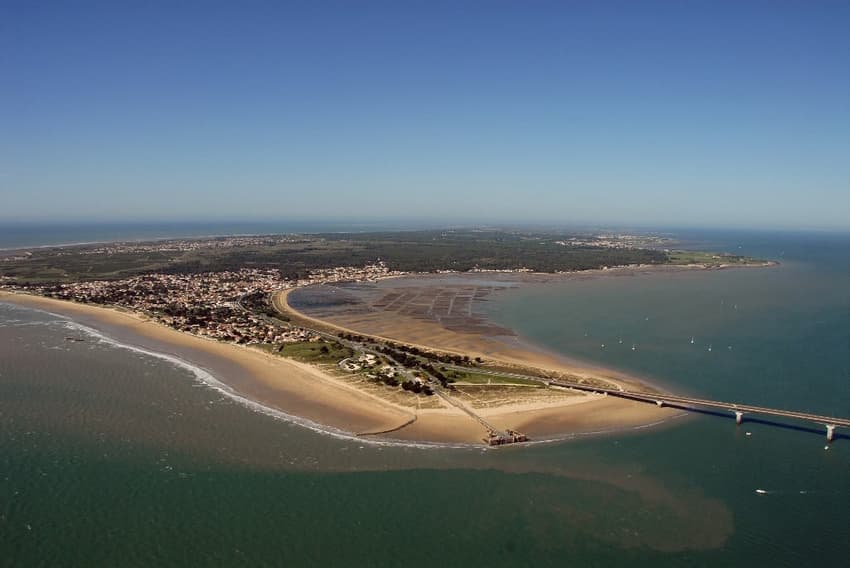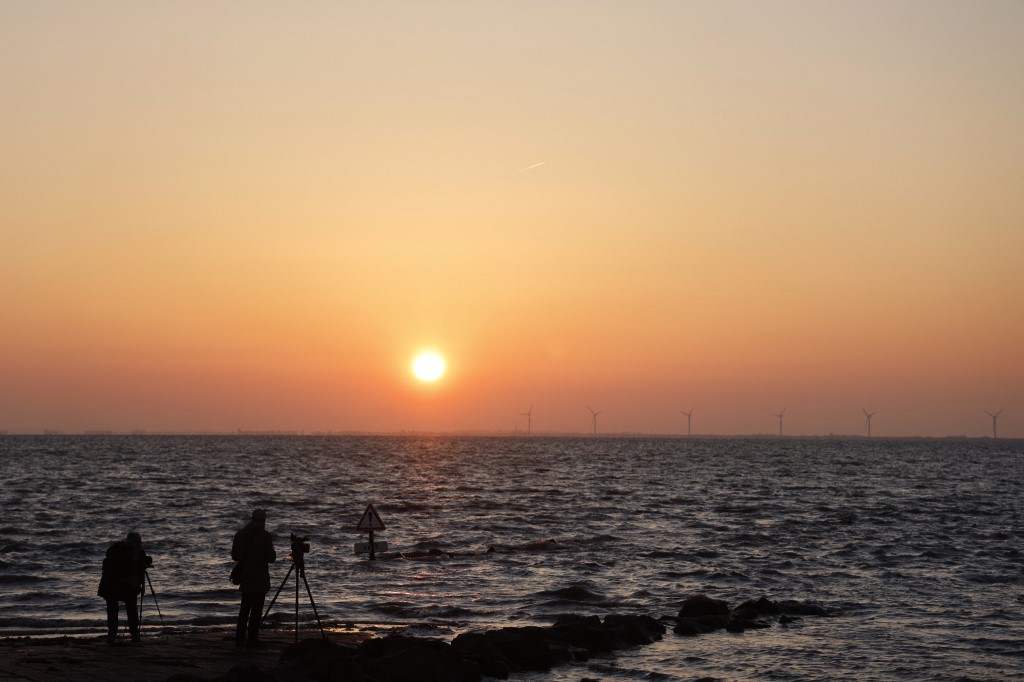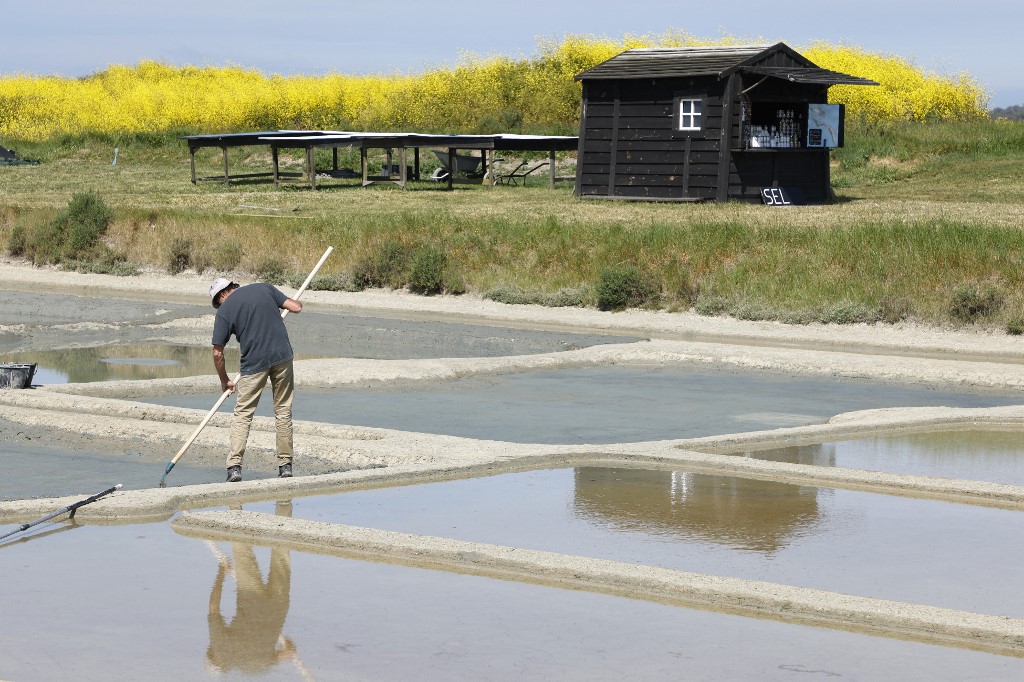3 French islands to visit this summer

Popular with French tourists but perhaps less well known to international visitors are the western islands of France - here's a look at three islands that you should add to your holiday list.
The largest island off the coast of mainland France - Corsica - is a very well-known tourist destination, but the three next biggest are lesser known among foreign tourists, although they are very popular with the French.
The islands of Île de Ré, Île d'Oléron and Île de Noimoutier are situated in the Atlantic ocean off France's west coast, and all three are accessible by car, via a causeway or bridge.

The bridge between La Rochelle and Ile de Re is the second longest in France at 3840 meters. Photo by XAVIER LEOTY / AFP
Ile de Ré
Where: the 85km sq island is just off the coast of La Rochelle in the Charente-Maritime département and is connected to the mainland by a bridge. The island’s winter population is 18,000 and that grows to 130,000 in the summer.
The island is sometimes known as the 'French Hamptons' after the American resort of The Hamptons where rich New Yorkers decamp in the summer, because a lot of very wealthy Parisians have holiday homes there.
Property on the island is therefore extremely expensive to buy, but don’t be put off by its reputation for wealthy holidaymakers there are actually plenty of hotels, rental cottages and campsites that are more reasonably priced.
Food: Seafood - especially oysters - and crèpes are both big on the island, and the local salt marshes produce a special kind of fleur de sel which is much sought after by cooks. Salted caramel is a popular sweet treat.
What to do: The island has lots of beautiful beaches, while inland there are walking trails and cycle paths where you can enjoy peace and quiet, nature and explore the several ruined fortifications along the coastline.
The several small towns including Saint-Martin-de-Ré and Sainte-Marie-de-Ré have a good selection of shops and places to eat, in fact there are several designer shopping boutiques to cater to all those rich Parisians.
The island is also famous for its herds of donkeys - which in the summer wear pyjamas and are known as les ânes en culotte - and you can buy special donkey milk soap that is made on the island

You can gather your own seafood on the beaches of Ile d'Oleron (or buy it in the market). Photo by XAVIER LEOTY / AFP)
Île d'Oléron
Where: Just south of Île de Ré is Île d’Oléron, the bigger island at 175 km sq, it too is connected to the mainland by a bridge.
It doesn't have quite the same reputation for wealthy visitors as Île de Ré, but it too is very much a tourist destination whose population swells in the summer. It has a large selection of hotels, campsites and rental cottages that can be booked all year round.
Food: As with Île de Ré, oysters are the local speciality and you can see large areas of land given over to oyster beds. The island also produces some great white wines that go particularly well with seafood, and it too has large areas of salt marsh that produce fleur de sel.

Phare de Chassiron. Photo by MARCEL MOCHET / AFP
What to do: The island is really beautiful and has a great network of cycle paths so it’s perfect to get around by bike. It also has several protected areas along the coastlines that have a great variety of wildlife, as well as beautiful beaches.
You can explore the Chateau d'Oléron and the Phare de Chassiron lighthouse that stands on the western tip of the island, looking out into the wild Atlantic (hold on to your hat, it's usually very breezy) and towards Canada.

Passage du Gois is a 4.1 km road connecting the gulf of Bourgneuf with Ile de Noirmoutier, which can only be crossed for a few hours each day when low tide occurs. Photo by Ludovic MARIN / AFP
Île de Noimoutier
Where: A bit further north is Île de Noirmoutier - it's to the south west of Nantes in the Vendée département. The smallest of the three it's about 50km sq. About a third of the island consists of salt marshes, producing more of that fleur de sel, and the rest is largely given over to tourism.
You can get to the island via a bridge but also by the famous Passage du Glois, a 4km road that links the island to the mainland and only appears at low tide. Be sure to check the times that it's open to avoid floating off into the Atlantic.

A salt worker prepares his salt marsh in Noirmoutier
Photo by Ludovic MARIN / AFP
Food: Noirmoutier is famous for its potatoes which grow exceptionally well in the sandy soil of the island. It also has a fabulous selection of seafood and due to its proximity to Nantes you will find historic Breton specialities like crèpes and cider.
One of the island's restaurants - La Marine on the very western tip of the island, was recently awarded a coveted third Michelin star for its locally-influenced cuisine.
What to do: Another island that's great for cyclists with a network of cycle paths and bike hire facilities, the island also has 40 km worth of beautiful beaches. Check out the pine forests and fine sandy beaches of Bois de la Chaise at the northern end of the island. Noirmoutier is also a great place to learn how to sail.
Comments
See Also
The largest island off the coast of mainland France - Corsica - is a very well-known tourist destination, but the three next biggest are lesser known among foreign tourists, although they are very popular with the French.
The islands of Île de Ré, Île d'Oléron and Île de Noimoutier are situated in the Atlantic ocean off France's west coast, and all three are accessible by car, via a causeway or bridge.

Where: the 85km sq island is just off the coast of La Rochelle in the Charente-Maritime département and is connected to the mainland by a bridge. The island’s winter population is 18,000 and that grows to 130,000 in the summer.
The island is sometimes known as the 'French Hamptons' after the American resort of The Hamptons where rich New Yorkers decamp in the summer, because a lot of very wealthy Parisians have holiday homes there.
Property on the island is therefore extremely expensive to buy, but don’t be put off by its reputation for wealthy holidaymakers there are actually plenty of hotels, rental cottages and campsites that are more reasonably priced.
Food: Seafood - especially oysters - and crèpes are both big on the island, and the local salt marshes produce a special kind of fleur de sel which is much sought after by cooks. Salted caramel is a popular sweet treat.
What to do: The island has lots of beautiful beaches, while inland there are walking trails and cycle paths where you can enjoy peace and quiet, nature and explore the several ruined fortifications along the coastline.
The several small towns including Saint-Martin-de-Ré and Sainte-Marie-de-Ré have a good selection of shops and places to eat, in fact there are several designer shopping boutiques to cater to all those rich Parisians.
The island is also famous for its herds of donkeys - which in the summer wear pyjamas and are known as les ânes en culotte - and you can buy special donkey milk soap that is made on the island

Île d'Oléron
Where: Just south of Île de Ré is Île d’Oléron, the bigger island at 175 km sq, it too is connected to the mainland by a bridge.
It doesn't have quite the same reputation for wealthy visitors as Île de Ré, but it too is very much a tourist destination whose population swells in the summer. It has a large selection of hotels, campsites and rental cottages that can be booked all year round.
Food: As with Île de Ré, oysters are the local speciality and you can see large areas of land given over to oyster beds. The island also produces some great white wines that go particularly well with seafood, and it too has large areas of salt marsh that produce fleur de sel.

What to do: The island is really beautiful and has a great network of cycle paths so it’s perfect to get around by bike. It also has several protected areas along the coastlines that have a great variety of wildlife, as well as beautiful beaches.
You can explore the Chateau d'Oléron and the Phare de Chassiron lighthouse that stands on the western tip of the island, looking out into the wild Atlantic (hold on to your hat, it's usually very breezy) and towards Canada.

Île de Noimoutier
Where: A bit further north is Île de Noirmoutier - it's to the south west of Nantes in the Vendée département. The smallest of the three it's about 50km sq. About a third of the island consists of salt marshes, producing more of that fleur de sel, and the rest is largely given over to tourism.
You can get to the island via a bridge but also by the famous Passage du Glois, a 4km road that links the island to the mainland and only appears at low tide. Be sure to check the times that it's open to avoid floating off into the Atlantic.

Photo by Ludovic MARIN / AFP
Food: Noirmoutier is famous for its potatoes which grow exceptionally well in the sandy soil of the island. It also has a fabulous selection of seafood and due to its proximity to Nantes you will find historic Breton specialities like crèpes and cider.
One of the island's restaurants - La Marine on the very western tip of the island, was recently awarded a coveted third Michelin star for its locally-influenced cuisine.
What to do: Another island that's great for cyclists with a network of cycle paths and bike hire facilities, the island also has 40 km worth of beautiful beaches. Check out the pine forests and fine sandy beaches of Bois de la Chaise at the northern end of the island. Noirmoutier is also a great place to learn how to sail.
Join the conversation in our comments section below. Share your own views and experience and if you have a question or suggestion for our journalists then email us at [email protected].
Please keep comments civil, constructive and on topic – and make sure to read our terms of use before getting involved.
Please log in here to leave a comment.